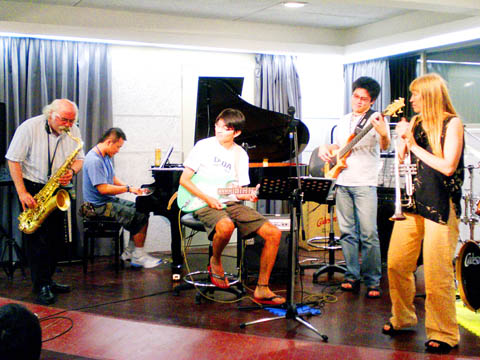How do you explain "swing" to someone who has never heard jazz? You don't, says jazz violinist Hsieh Chi-pin (謝啟彬). You play it.
And this is exactly what Hsieh and his fellow musicians are doing in a series of lectures aimed at introducing jazz to general, non-musician audiences.
The lectures, a precursor to this summer’s Taipei International Jazz Festival, started on Thursday at the KHS music store (�?嶺絳秶U) on Fuxing South Road in Taipei.

PHOTO: COURTESY OF TAIPEI INTERNATIONAL JAZZ EDUCATION AND PROMO
Hsieh and his wife, pianist Chang Kaiya (張凱雅), started the lectures three years ago, partly in response to a common reaction they received from concert audiences.
“They were interested and curious [about jazz] but felt frustrated … they didn’t know what records to get, or how to enjoy the music,” he said.
Hsieh and several musicians begin each lecture by playing a song in a particular style. Then they explain what defines the style, replaying parts of a song to illustrate their point.
Playing the music live helps, Hsieh says, but so does appealing to “local humor.” He demonstrates the concept of swing by telling the audience to imagine street-vendors yelling out “Daw-lap” — the Hoklo word for the southern Taiwanese city of Douliou (斗六). He then started chanting “Daw-lap, Daw-lap, shoo-bee-do, Daw-lap,” in a playful swing rhythm.
The audience laughed, but even better — they came away with a good understanding of swing, said Hsieh.
The lecture format has helped novices in telling the differences among the many styles of jazz, says Hsieh. “All the terms are scary at first, but after one hour, they understand,” he said. Students quickly learn how to identify “cool jazz” or “post-bop.”
There are a total of 10 two-hour lectures, covering basic jazz forms and instrumentation, and a chronological overview of jazz styles: from New Orleans and swing to avant-garde and fusion.
One basic lesson taught early on is concert etiquette: the audience learns to express their appreciation more freely — as opposed to a classical concert — by clapping after solos during a song.
The lectures are just the beginning of this year’s jazz season in Taipei. The organizer, the Taipei International Jazz Education and Promotion Association, is also holding a one-week summer camp for jazz musicians at Shih Chien University (實踐大學).
The courses at the camp will be taught by musicians and teachers from the US and Europe, who will also hold performances this summer as part of the Taipei International Jazz Festival. Such “exchanges” are important to Hsieh who teaches at the camp and hopes Taiwan can develop its own jazz scene.
Hsieh says with the camp and the lectures, the association hopes that “more people will appreciate this art form” and understand that jazz is a life-long endeavor for musicians.
The first lecture has already been held, but registration remains open. The lectures take place once a week through July 10, from 7pm to 9pm every Thursday, at the KHS music store on Fuxing South Road. The registration fee is NT$2,000. All lectures are held in Mandarin. Check the association’s Web site for details on the summer camp and jazz festival performances, which take place in June and July.

Wooden houses wedged between concrete, crumbling brick facades with roofs gaping to the sky, and tiled art deco buildings down narrow alleyways: Taichung Central District’s (中區) aging architecture reveals both the allure and reality of the old downtown. From Indigenous settlement to capital under Qing Dynasty rule through to Japanese colonization, Taichung’s Central District holds a long and layered history. The bygone beauty of its streets once earned it the nickname “Little Kyoto.” Since the late eighties, however, the shifting of economic and government centers westward signaled a gradual decline in the area’s evolving fortunes. With the regeneration of the once

Even by the standards of Ukraine’s International Legion, which comprises volunteers from over 55 countries, Han has an unusual backstory. Born in Taichung, he grew up in Costa Rica — then one of Taiwan’s diplomatic allies — where a relative worked for the embassy. After attending an American international high school in San Jose, Costa Rica’s capital, Han — who prefers to use only his given name for OPSEC (operations security) reasons — moved to the US in his teens. He attended Penn State University before returning to Taiwan to work in the semiconductor industry in Kaohsiung, where he

In February of this year the Taipei Times reported on the visit of Lienchiang County Commissioner Wang Chung-ming (王忠銘) of the Chinese Nationalist Party (KMT) and a delegation to a lantern festival in Fuzhou’s Mawei District in Fujian Province. “Today, Mawei and Matsu jointly marked the lantern festival,” Wang was quoted as saying, adding that both sides “being of one people,” is a cause for joy. Wang was passing around a common claim of officials of the People’s Republic of China (PRC) and the PRC’s allies and supporters in Taiwan — KMT and the Taiwan People’s Party — and elsewhere: Taiwan and

Perched on Thailand’s border with Myanmar, Arunothai is a dusty crossroads town, a nowheresville that could be the setting of some Southeast Asian spaghetti Western. Its main street is the final, dead-end section of the two-lane highway from Chiang Mai, Thailand’s second largest city 120kms south, and the heart of the kingdom’s mountainous north. At the town boundary, a Chinese-style arch capped with dragons also bears Thai script declaring fealty to Bangkok’s royal family: “Long live the King!” Further on, Chinese lanterns line the main street, and on the hillsides, courtyard homes sit among warrens of narrow, winding alleyways and